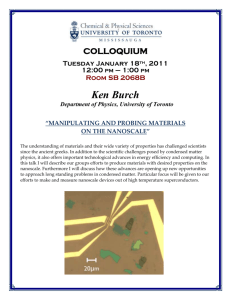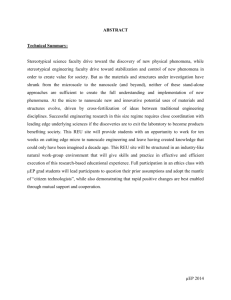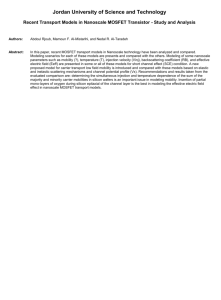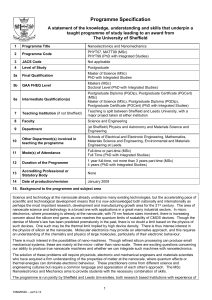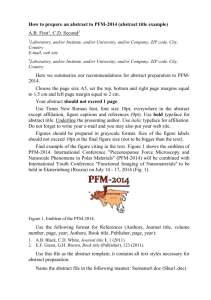MSc - University of Sheffield
advertisement
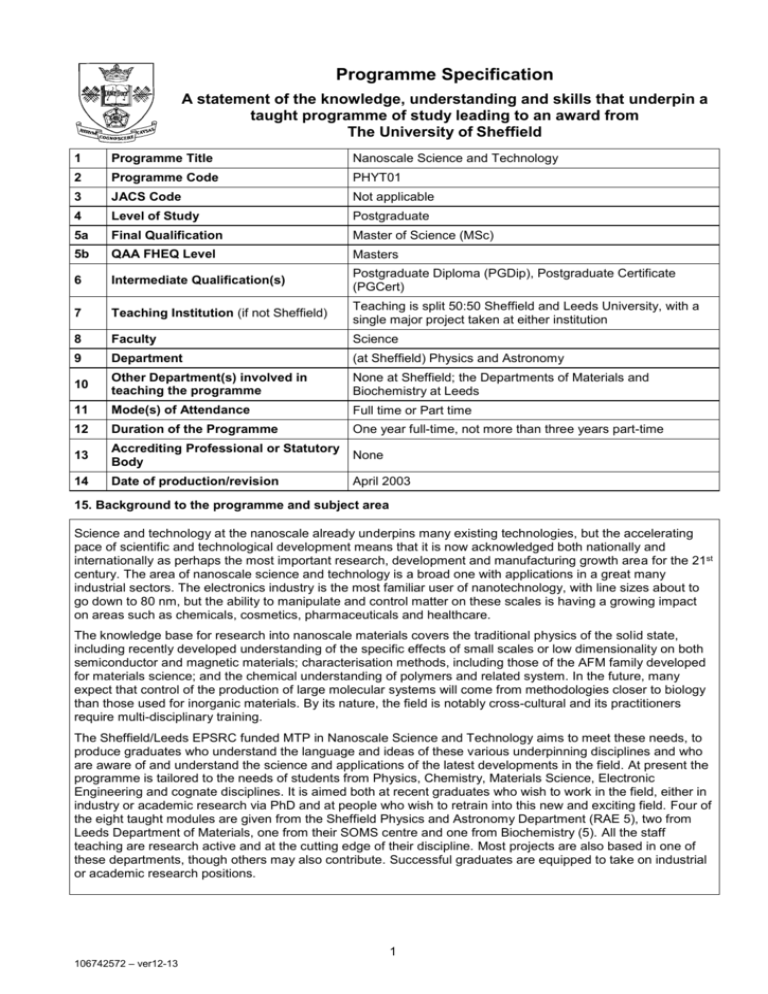
Programme Specification A statement of the knowledge, understanding and skills that underpin a taught programme of study leading to an award from The University of Sheffield 1 Programme Title Nanoscale Science and Technology 2 Programme Code PHYT01 3 JACS Code Not applicable 4 Level of Study Postgraduate 5a Final Qualification Master of Science (MSc) 5b QAA FHEQ Level Masters 6 Intermediate Qualification(s) Postgraduate Diploma (PGDip), Postgraduate Certificate (PGCert) 7 Teaching Institution (if not Sheffield) Teaching is split 50:50 Sheffield and Leeds University, with a single major project taken at either institution 8 Faculty Science 9 Department (at Sheffield) Physics and Astronomy 10 Other Department(s) involved in teaching the programme None at Sheffield; the Departments of Materials and Biochemistry at Leeds 11 Mode(s) of Attendance Full time or Part time 12 Duration of the Programme One year full-time, not more than three years part-time 13 Accrediting Professional or Statutory Body None 14 Date of production/revision April 2003 15. Background to the programme and subject area Science and technology at the nanoscale already underpins many existing technologies, but the accelerating pace of scientific and technological development means that it is now acknowledged both nationally and internationally as perhaps the most important research, development and manufacturing growth area for the 21st century. The area of nanoscale science and technology is a broad one with applications in a great many industrial sectors. The electronics industry is the most familiar user of nanotechnology, with line sizes about to go down to 80 nm, but the ability to manipulate and control matter on these scales is having a growing impact on areas such as chemicals, cosmetics, pharmaceuticals and healthcare. The knowledge base for research into nanoscale materials covers the traditional physics of the solid state, including recently developed understanding of the specific effects of small scales or low dimensionality on both semiconductor and magnetic materials; characterisation methods, including those of the AFM family developed for materials science; and the chemical understanding of polymers and related system. In the future, many expect that control of the production of large molecular systems will come from methodologies closer to biology than those used for inorganic materials. By its nature, the field is notably cross-cultural and its practitioners require multi-disciplinary training. The Sheffield/Leeds EPSRC funded MTP in Nanoscale Science and Technology aims to meet these needs, to produce graduates who understand the language and ideas of these various underpinning disciplines and who are aware of and understand the science and applications of the latest developments in the field. At present the programme is tailored to the needs of students from Physics, Chemistry, Materials Science, Electronic Engineering and cognate disciplines. It is aimed both at recent graduates who wish to work in the field, either in industry or academic research via PhD and at people who wish to retrain into this new and exciting field. Four of the eight taught modules are given from the Sheffield Physics and Astronomy Department (RAE 5), two from Leeds Department of Materials, one from their SOMS centre and one from Biochemistry (5). All the staff teaching are research active and at the cutting edge of their discipline. Most projects are also based in one of these departments, though others may also contribute. Successful graduates are equipped to take on industrial or academic research positions. 1 106742572 – ver12-13 The MSc website at http://www.ee.leeds.ac.uk/nanomsc/ provides both an overview of the programme with application forms, and an essential resource for current students with module descriptions, objectives, syllabuses, programme material, assessment weights and deadlines, contact details and so on. It also includes a nanotechnology database and a glossary of terms used in the discipline and the programme. More information about the Physics and Astronomy Department, the staff, programmes and admissions can be found on the Web at http://www.shef.ac.uk/physics. 16. Programme aims All programmes of study offered by the Department of Physics and Astronomy have the following general aims, consonant with the Mission Statement of the University of Sheffield: 1. to provide teaching at undergraduate and postgraduate levels that is informed and invigorated by the research and scholarship of the staff and is stimulating, useful and enjoyable to students from a wide variety of educational backgrounds; 2. to produce graduates with well-developed practical, analytical, communication, IT and problem-solving skills who readily find employment in industry, the professions and public service; 3. to address a wide diversity of student interests and aspirations through degree programmes which retain flexibility and choice while furnishing a well-rounded understanding of the subject; 4. to encourage and develop our students’ desire for learning and to support their development of appropriate interpersonal and transferable skills; 5. to sustain a culture of teaching and research that is able to foster the free pursuit of knowledge and the rigorous, quantitative analysis of information. 6. The specific aims of the MSc in Nanoscale Science and Technology are: 7. to produce graduates with an understanding of the fundamental laws and principles of physics, chemistry and biology relevant to Nanoscale Science, and a familiarity with the languages of these different disciplines; 8. to produce graduates who understand the way in which these disciplines converge at the nanoscale; the implications of this convergence; and some of the likely applications and limitations of nanoscale technology; 9. to develop students’ ability within the context of the major project to execute experiments and analyse the results using a variety of experimental techniques and methods at the forefront of current research in nanoscale technology; 10. to develop an independence in the experimental design, execution and analysis within a supervised research project; 11. to prepare students for a professional career either within or beyond the field of nanoscale technology. 17. Programme learning outcomes Knowledge and understanding: By the end of the programme students will have developed: K1 an understanding of the inter-relationships between the ideas of physics, chemistry, materials science and biology at small scales, a familiarity with the language of these disciplines and an appreciation of how these disciplines come together at nanometre scales. K2 a sound grasp of the way in which the fundamental laws and principles of physics and chemistry determine nanoscale behaviour, and the ability to apply these ideas to solve problems and understand the behaviour of natural and/or man-made nanoscale systems. K3 an understanding of the role of self-organised systems, both organic and inorganic, and of the production of biological nanoscale structures in nature. K4 a knowledge and sound grasp of the current understanding of a wide range of nanoscale systems, including those at the forefront of current research. K5 a knowledge and understanding of the current and future applications of nanoscale technology, the areas of most likely rapid growth and the fundamental limits provided by physics and chemistry. K6 a knowledge, familiarity and understanding of the methods of production, characterisation and analysis of a wide range of nanoscale materials. K7 familiarity with state of the art computer modelling of nanoscale systems. 2 106742572 – ver12-13 K8 familiarity with basic laboratory equipment and techniques, including knowledge of safe working practices. K9 familiarity with advanced experimental techniques used at the leading edge of the subject, and the data reduction, limitations and interpretation methods associated with it. K10 a knowledge of and familiarity with the range of data sources used by workers in this field. Skills and other attributes: S1 the ability to analyse the properties of materials and devices in terms of their physics and chemistry in both a quantitative and quantitative way. S2 the ability to interpret key properties of materials in terms of mathematical descriptions capable of either analytical or numerical solution, so as to deduce their behaviour and properties. S3 the ability to use the literature, in the form of books, journals and websites independently, with the emphasis on primary sources and peer reviewed material. S4 the ability to plan and execute an experimental programme. S5 the ability to use state of the art equipment and the supporting instrumentation found in a modern laboratory, including their computer control and analysis systems. S6 the ability to analyse the results of experiments, calculations and simulations critically and quantitatively, making use of appropriate software packages as appropriate, and to draw valid conclusions. S7 the ability to communicate scientific ideas and experimental results clearly, concisely and effectively, both orally and in writing, with proper regard for the needs of the audience. S8 effective use of IT skills in data analysis and/or numerical simulation or solution of physical or mathematical systems, together with the use of standard word processing, graphics software and presentational packages. 18. Teaching, learning and assessment Development of the learning outcomes is promoted through the following teaching and learning methods: 1. Lectures The standards required of a postgraduate in the physical sciences include the acquisition of a substantial body of knowledge (K1-7, K9-10). This is conveyed principally through traditional lectures, about 17 per module. Problems are provided as formative assessment (S1-2). 2. Tutorials and Laboratory sessions The lecture material is explored and extended in tutorials and laboratory sessions, which may be demonstrations or practical assignments (K8-9) according to the nature of the programme and the equipment involved. These sessions may, as appropriate contain hands-on computer based exercises. 3. Communication and Information skills All modules require at least one 2000 word essay and also require students to access the original literature plus advanced text books (S3). The essay assessment generally involves a presentation (S6-8) or oral exam. Some modules provide team-work exercises, typically through case study development (S4). 4. Major project This contributes one third of the total credits. It falls into three sections. There is a period of preparation, including reading about the chosen topic (S3, K4, K10) and planning (S4), and this is summarised in a written report (S7). The major part of the project is spent in the laboratory, and the exact mix of skills and knowledge acquired depends on the particular project, but most will include K1, K2, K6, K8 and K9, plus S1, S2, S4, S5, S6 and S8. The project concludes with a presentation (S7, S8) and a written report (S7). 3 106742572 – ver12-13 Opportunities to demonstrate achievement of the learning outcomes are provided through the following assessment methods: 1. Essays/Reports Essays or reports feature in the assessment schemes of all taught modules (K1-7, K9-10). With one exception, which uses a 1000 word format, they are all 2000 words long and contribute 50% of the marks for each module. These provide an opportunity for the students to demonstrate their knowledge and understanding of the material, and their ability to communicate this information. They are marked according to content, clarity of exposition, language and style, following marking schemes which are available to the students. Written feedback is provided. 2. Exams and problems Three of the taught modules use formal two-hour exams for part of their assessment; each exam contributes 50% of that module’s marks. Exams provide effective tests of knowledge (K1-7, K9-10). and basic problem solving skills (S1-2). One of the exams is in an innovative multiple-choice format (unusual in the physical sciences), and one is an open book exam (on generic methodologies). Four modules use problem sheets instead of exams to address the problem-solving skill issue(S1-3). These contribute 25% of the marks for the module. These modules also contain a third assessment method, for example a laboratory or computer simulation based exercise (marked both on the accomplishment of the exercise and its reporting), or a presentation on a selected nanostructure based device (K4-8). These also contribute 25%.of the marks for the module. The bio-nanotechnology module, being less quantitative than the others, uses a 2000 word essay + oral presentation + (practical + report) methodology. 3. The Major Project Each project has a primary and a secondary supervisor, concerned with both progress and assessment. The assessment of the three written reports and one oral is by them jointly, following a publicly available pro-forma report sheet. The preliminary report is weighted at 5%, the interim at 10% and the final report at 20%; the oral exam counts for 15%. Two assessments of the progress and achievement in the lab are made by the first supervisor, one in April and the other at the end of the project, contributing a total of 40%. A final contribution of 10% comes from the assessment of the presentation of the work; the assessors here are two other members of staff (S3-8, K6, K8-10). 19. Reference points The learning outcomes have been developed to reflect the following points of reference: Subject Benchmark Statements http://www.qaa.ac.uk/AssuringStandardsAndQuality/subject-guidance/Pages/Subject-benchmarkstatements.aspx Framework for Higher Education Qualifications (2008) http://www.qaa.ac.uk/Publications/InformationAndGuidance/Pages/The-framework-for-higher-educationqualifications-in-England-Wales-and-Northern-Ireland.aspx University Strategic Plan http://www.sheffield.ac.uk/strategicplan Learning and Teaching Strategy (2011-16) http://www.shef.ac.uk/lets/strategy/lts11_16 The teaching and learning strategies of the Department of Physics and Astronomy; and those of the University of Leeds 20. Programme structure and regulations The taught modules occupy the first semester and the second up until Easter. The project starts before Christmas and ends in the Summer. The eight taught modules carry 15 credits each, and the project 60. Taught modules can be re-sat. The MSc is awarded to candidates with 180 credits, i.e. a pass on all modules. The MSc is not classified, though 4 106742572 – ver12-13 the Teaching Committee have the right to award a distinction in exceptional cases; the degree is awarded if all modules are passed. If a candidate obtains 120 credits on the programme, s/he may, with the examiners’ approval be awarded the Postgraduate Diploma in Nanoscale Science and Technology. Candidates with 60 credits from the taught modules may be awarded the Postgraduate Certificate in Nanoscale Science and Technology. Candidates may also choose to take the Diploma or the Certificate from the outset, taking specified combinations of modules to the required credit total. Because of the variety of possible combinations, no separate learning outcomes are given for these awards. Detailed information about the structure of programmes, regulations concerning assessment and progression and descriptions of individual modules are published in the University Calendar available on-line at http://www.shef.ac.uk/govern/calendar/regs.html. 21. Student development over the course of study As a one year programme, there is no progression in the usual sense of movement from year to year. Students do go from an introductory, generic module at the start, through seven further taught modules containing advanced material, whilst undertaking an advanced research project. There are no module choices to be made, so no advisors are required. However, students may consult with the Course Director (at Leeds) or the Co-Director (at Sheffield) over general issues and problems. 22. Criteria for admission to the programme Detailed information regarding admission to the programme is available at http://www.shef.ac.uk/prospective/ A lower second or better degree in Physics, Chemistry, Materials Science, Electronic Engineering or equivalent; Detailed information regarding admission to the programme is available and an application form is available on the programme website http://www.shef.ac.uk/physics. 23. Additional information This specification represents a concise statement about the main features of the programme and should be considered alongside other sources of information provided by the teaching department and the University. In addition to programme specific information, further information about studying at The University of Sheffield can be accessed via our Student Services web site at http://www.shef.ac.uk/ssid. 5 106742572 – ver12-13
